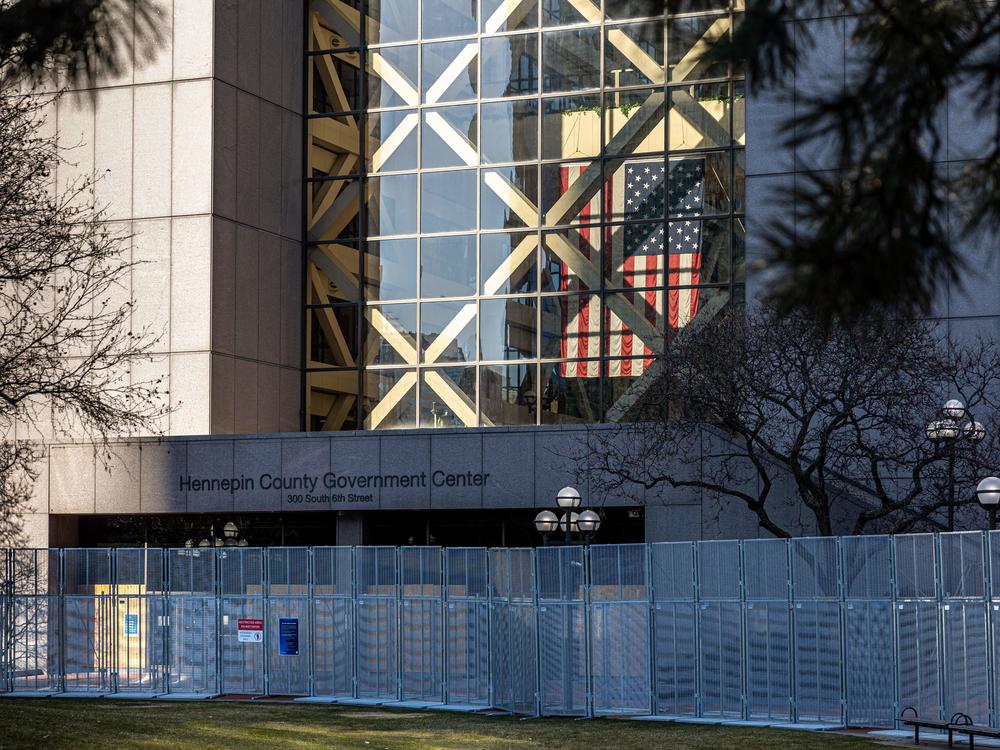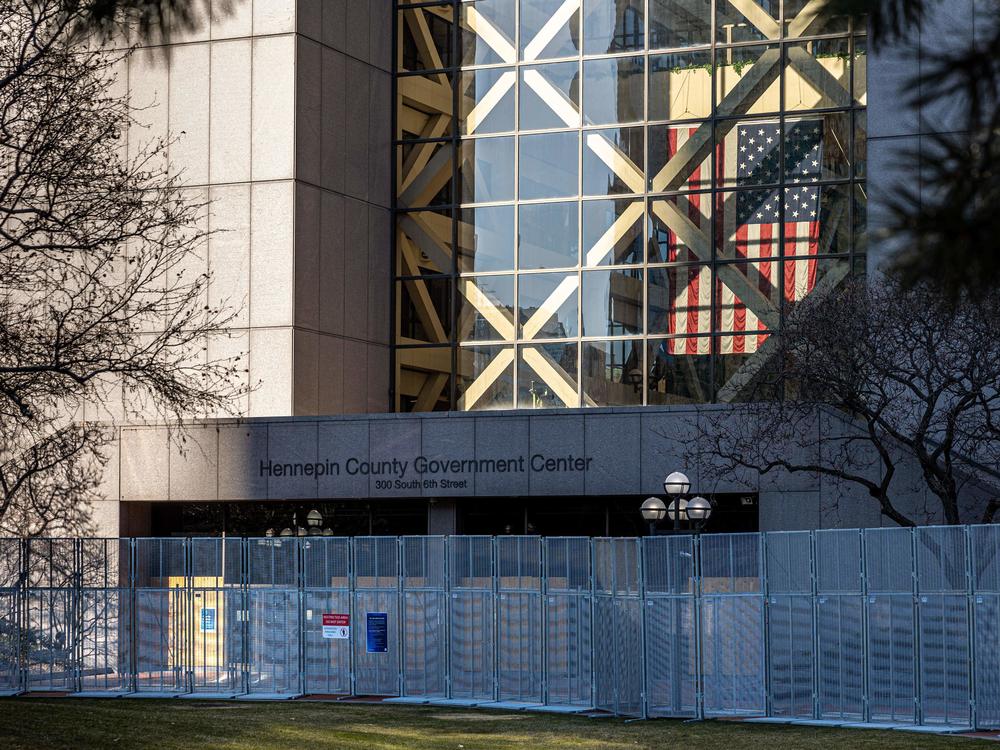Section Branding
Header Content
Trial Day 1: 'Mr. Derek Chauvin Betrayed This Badge'
Primary Content
Updated March 29, 2021 at 10:04 PM ET
The first day in the murder trial of former Minneapolis police officer Derek Chauvin, who is accused of killing George Floyd in May, featured an intense series of opening arguments, numerous photographs and videos of the killing, and testimony from three witnesses.
The trial is starting in earnest 10 months after George Floyd's killing triggered outrage and protests against racial inequality across the United States. And the first day ended with a "major technical glitch" interrupted the video feed being carried by news networks and watched by Floyd's family members in a neighboring court room.
Chauvin, who is white, is charged with second-degree unintentional murder, third-degree murder and second-degree manslaughter in the death of Floyd, a Black man. Video recordings show that Floyd was handcuffed and held facedown on the asphalt and that Chauvin kept his knee on Floyd's neck for nearly nine and a half minutes.
Prone Restraint Is Central Factor In Opening Statements
"Mr. Derek Chauvin betrayed this badge," Special Assistant Attorney General Jerry Blackwell told the jury after outlining police policies and the oath that Chauvin took when he became an officer.
The prosecutor immediately delved into what he said is indisputably an excessive use of force. He also said there is a misconception that Floyd was held face down under Chauvin's knee for 8 minutes and 46 seconds. Blackwell said it was actually 43 seconds longer than that - 9 minutes and 29 seconds.
"Citizens who are under arrest should never be put in the prone position except only momentarily to get them under police custody or control," he told the jury.
As he spoke, Blackwell showed jurors a photo from the scene in which Chauvin has his knee on Floyd's neck.
"The dangers of the prone position – putting people face down on the ground – have been know about in policing for over 30 years," Blackwell said.
Blackwell told the jurors that they will learn that Floyd's body was making involuntary movements while he was being held down by Chauvin, including a seizure and "agonal breathing" from oxygen deprivation.
After Chauvin was told twice that Floyd did not have a pulse, "he does not let up, and he does not get up," Blackwell said, adding that the officer did not move off of Floyd even as a paramedic sought a pulse.
Blackwell also noted that Chauvin was fired shortly after the encounter.
In his opening statement, Chauvin's defense attorney, Eric Nelson, told jurors, "The use of force is not attractive but it is a necessary component of policing."
Chauvin, he added, "did what he was trained to do."
Nelson warned the jury that the trial will bring several significant battles over how some facts are interpreted. Chief among them, he said, will be the cause of death.
"The evidence will show that Mr. Floyd died of a cardiac arrhythmia that occurred as a result of hypertension, his coronary disease, the ingestion of methamphetamine and fentanyl, and the adrenaline flowing through his body — all of which acted to further compromise an already compromised heart," Nelson said.
Nelson also noted that the autopsy performed by Hennepin County Medical Examiner found no evidence that Floyd died of asphyxiation.
Describing Floyd's actions on the day he died, Nelson said, "The evidence will show that when confronted by police, Mr. Floyd put drugs in his mouth in an effort to conceal them from police."
When jurors weigh the evidence and the law and "apply reason and common sense," Nelson said, "there will only be one just verdict, and that is to find Mr. Chauvin not guilty."
Nelson also offered the theory that the reason the officers let Floyd die was because they were distracted by a chaotic crowd that "diverted their attention" from the man below the weight of their bodies. He suggested that if the bystanders who were pleading with the officers to release Floyd had not been there, they would have acted differently.
The Hennepin County medical examiner ruled last June that Floyd's death was a homicide, saying his heart and lungs stopped functioning "while being restrained."
The autopsy report cited neck compression, but it also noted "other significant conditions," including fentanyl intoxication, recent methamphetamine use and signs of heart disease.
Witnesses testify: 'Something is wrong'
The first witness called to the stand on Monday was Minneapolis 911 dispatcher Jena Scurry who directed police to Cup Foods after getting a call about a man with a counterfeit bill.
Scurry testified that despite several years of experience handling emergency calls, she became concerned when her monitors showed the responding officers, including Chauvin, kneeling on top of Floyd and pinning him to the ground.
She initially believed the screen had frozen, then realized that was not the case, she told the court.
"My instincts were telling me that something was wrong. Something wasn't right," said Scurry, who had a view of the interior of the squad car from which Floyd was dragged. "It was an extended period of time. ... They hadn't told me if they needed more resources."
After watching the live video feed for several minutes, Scurry essentially called the police on the police. She called the sergeant in charge of the officers, saying she didn't want to be "a snitch," then reported what she was seeing on her screen.
When asked, she said she'd never done anything like that before.
Alisha Oyler, who recorded seven separate videos of the incident as she was working as a cashier across the street from where Floyd was killed, was next to take the stand.
In her testimony Olyer said she did not witness Floyd resisting arrest. When asked why she began filming in the first place she responded, "Because I always see the police ... they're always messing with people. And its wrong and it's not right."
The final witness of the day was Donald Williams, a martial arts trained fighter who was standing a few feet away as Chauvin forced his knee onto Floyd's neck.
Prosecutors walked Williams through several explanations of the different types of chokeholds the 33-year-old has learned in his training. At one point, Blackwell presented a photograph of Chauvin with his hands in his pockets as he pinned Floyd to the ground. The former officer is looking straight at the camera.
"The only reason he's looking at me right now is because I told him it was a 'blood choke,' " Williams said.
He described how Floyd gasped for air, saying he couldn't breathe. How he called for his mother and children and begged for his life.
"You're not investigators"
Several legal questions will likely determine the outcome of the case:
- Do legal protections for police absolve Chauvin of responsibility for Floyd's death?
- Could it be considered "reasonable" for Chauvin to have used the amount of force he did?
- To what degree could other factors, such as Floyd's recent drug use and his health, have contributed to his death?
- If Chauvin is found to have directly caused Floyd's death, which of the three charges would jurors agree on?
The 12 jurors and two alternates were sworn in shortly after 9:20 a.m. local time. Afterward, Hennepin County Judge Peter Cahill told jurors they can tell only their immediate family that they're on this case — and he reminded them to avoid any media coverage or attempt to do their own research.
"You are not investigators," Cahill said.
The highly anticipated trial is being watched closely, as Floyd's family and their supporters call for justice in what they say was an excessive use of force. Chauvin's supporters say the officer used force only after Floyd resisted being put in a police car.
To reach the courtroom hosting the trial, jurors and attorneys have to pass through an elaborate set of security measures — including barricades, fencing and concertina wire — that surround the court building.
In recent weeks, Cahill denied defense motions to move the trial outside Minneapolis or to delay the proceedings until publicity about the case eases.
"I do not think that that would give the defendant any kind of a fair trial beyond what we are doing here today," Cahill said as he issued his ruling. "I don't think there's any place in the state of Minnesota that has not been subjected to extreme amounts of publicity on this case."
Public awareness of the trial also became a concern after the city of Minneapolis reached a $27 million settlement with Floyd's family.
After that news broke, two jurors told the court that they could no longer promise to be impartial, and they were struck from the panel. In one juror's words, the payout made him believe the city was admitting that "something was wrong," according to Minnesota Public Radio.
The jury includes one Black woman, three Black men (two of whom are immigrants) and two women who identify as multiracial — making the panel more diverse than Minneapolis. The remainder of the jurors and alternates are white, including six women.
An historic trial
The Chauvin trial is already making history in Minnesota, where it is the state's first case to be broadcast live on TV and streaming services. Minnesota has previously barred nearly all live video coverage from inside courtrooms, but Cahill opted to give unprecedented access to this case due to massive public interest.
Evidence presented during the trial has included recordings from the day Floyd died, including the dramatic video in which Chauvin is seen pinning Floyd to the asphalt.
"Please, please. I can't breathe," Floyd repeatedly said before he died.
Chauvin and the other three police officers who were at the scene — Tou Thao, J. Alexander Kueng and Thomas K. Lane — were fired one day after Floyd was killed. They were arrested several days later. Thao, Kueng and Lane are facing charges of aiding and abetting murder.
After his death last Memorial Day, Floyd's name quickly became a rallying call for the Black Lives Matter movement and its allies. His death, along with other high-profile police killings of Black people, from Breonna Taylor in Louisville, Ky., to Jonathan Price in Wolfe City, Texas, brought new scrutiny to long-entrenched racism in the U.S., particularly the decades of deadly violence Black Americans have endured since slavery was outlawed.
In the past year, communities around the U.S. have been reexamining the historical figures and monuments they honor, resulting in the removal of nearly 100 Confederate monuments in 2020. Hundreds more of the monuments remain in place, according to an annual survey by the Southern Poverty Law Center.
The court will convene at 9 a.m. CT each day for the trial, which is expected to last about four weeks. You can follow the proceedings on NPR and at member station Minnesota Public Radio, which is livestreaming video coverage from the courtroom.
Copyright 2021 NPR. To see more, visit https://www.npr.org.


